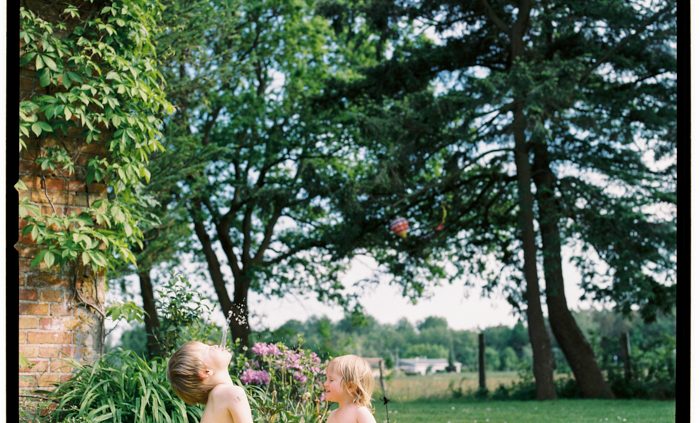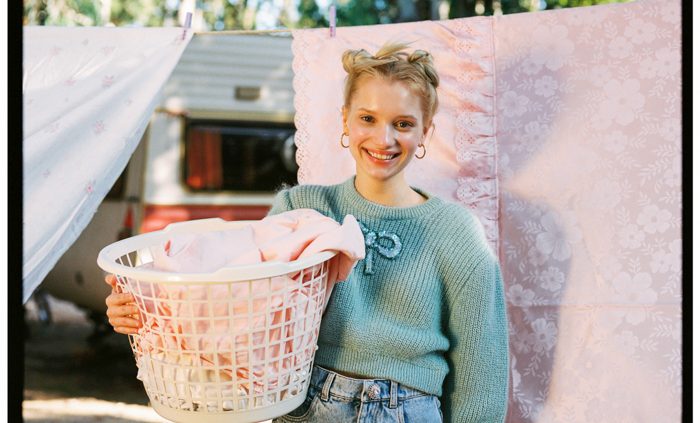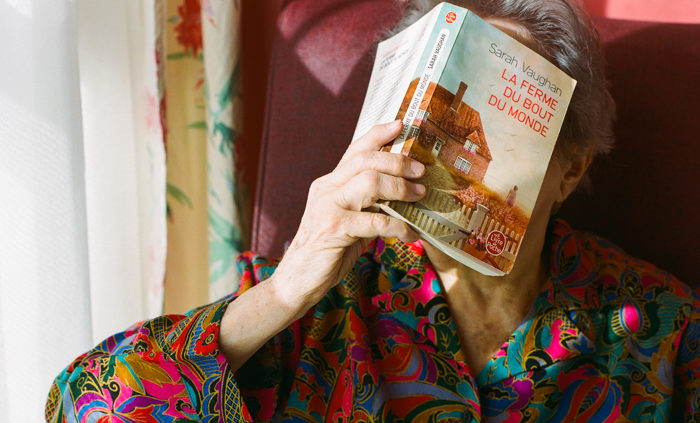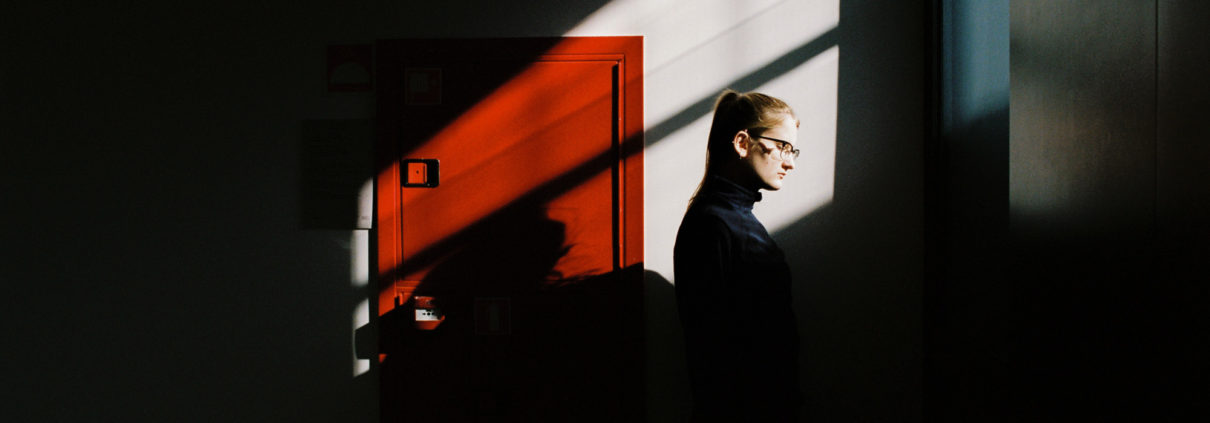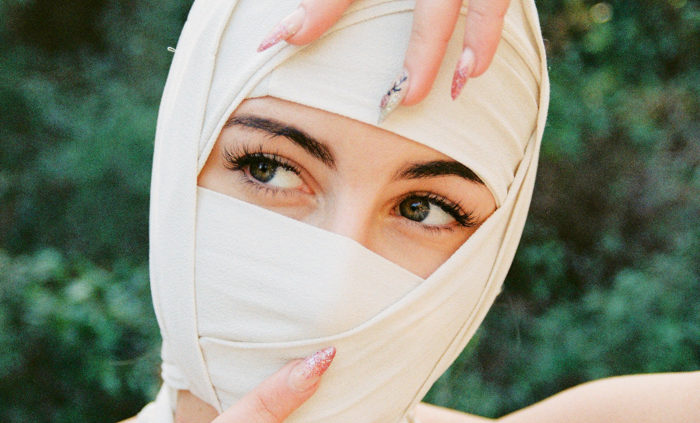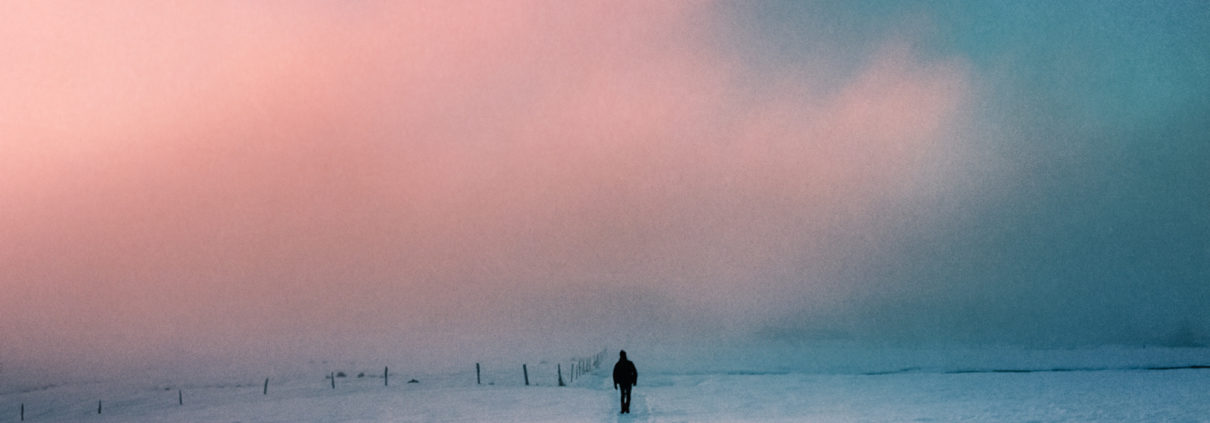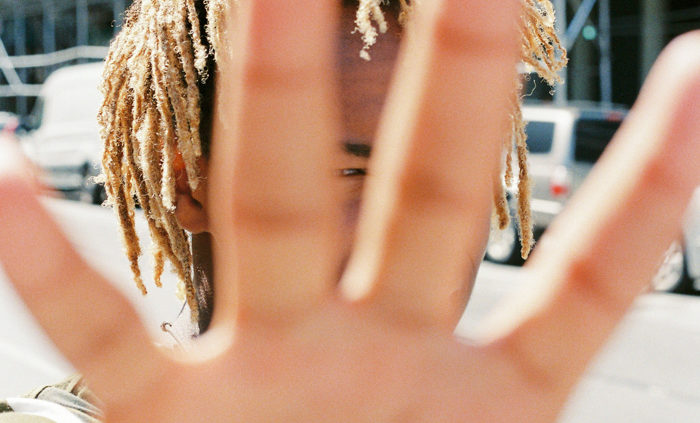Few Frames w/ Michael Ferire
A DIFFERENT BACKSTAGE
We’ve known Michael Ferire for a long time already, one morning a package with single frames cut into an old 10×15 photo album appeared with his name and asking us to do the best we could. Little we knew that was gonna become the beginning of a long relationship. Earlier this year he sent this shot he did with Stromae and the team behind his clothing brand Mosaert. It was a big shot combining 4×5″ film with 120 in 6×7 & 645 format and specially lit with studio lights.
Many years ago we asked Michael in a personal conversation how would he describe his photography, and he said: “I’m a backstage photographer“. Definitely not the answer that we could have anticipated, but it made total sense with his photography. Michael always tries to portray what’s behind of what we see, perhaps his background on psychology has something to do with that, and in this case, flipping the traditional concept of not being present in the image but rather being present to show what’s behind, in this case behind the brand of Mosaert.
In his words:
“The paradox of the project: being visible without being too present
This project was a bit crazy. The idea was to create iconic images that could be the expression of the creative label Mosaert (mainly known for the creative work they made for Stromae but also active in fashion design, video clips and other projects). For me, it was a total non-sens to be so accurate on the expression of the brand and the consistency of each project they make without having a proper vision on how to communicate on the team itself.
I presented, therefore, a global project based on the idea of bold images with a clear identity but I knew that the tricky part would be to make sure that these images will stay on the second level of communication. Mosaert needs to communicate clearly about their products and not specifically about themselves. So this shoot should provide the same aesthetics but stay more subtle and discrete.
Inspiration: timeless and bold
Artistic background: I really wanted to create pictures like a painter do it. So I decided to find inspiration mainly in art and more specifically in Art Nouveau or Art Deco. This aesthetic is already very present in Mosaert’s DNA and also representative of Belgium which is also a characteristic of this project. Artistic background came from different sources like MC Escher and Art Nouveau in general.
The place was very obvious since we wanted a retro-futuristic place with a very Belgian legacy. With Studio Elementaires (scenographers) we decided to amplify the graphic potential of the place using forms and counter forms to create an Atelier Brancusi mood. The idea was to create a very singular atmosphere taking inspiration in different artistic traditions. It had to be retro and futuristic at the same time.
For poses and attitudes, I wanted something bold and neutral at the same time which is a challenge. For me, it was clear that we had to consider bodies and faces as graphical elements in the construction of images. This solution would be able to provide the “neutral boldness” that we were looking for. I found inspiration mainly in Irving Penn’s work.
Light and mood: We wanted something very clean for the lighting. Something that would seem natural and supernatural at the same time. A mood somewhere in-between the organicity of the film and a clinical perfection that could be 3D images. The same paradox that we had in attitudes and poses : that « neutral boldness ». The aim, with Julien Charpentier (DOP in the film industry), was to create very soft and timeless light.
I also wanted to work with 4x5inch which is a format I never used and which seemed very technical and risky when it’s your first try. I decided to work with Elliott Verdier (that I met on Traveling Light last year). I knew that it would be the perfect solution to be able to do it without having the stress of all the technical aspects of large format and be more focused on the vision and the artistic direction.
We worked together as a team. For each pose, each idea, I shot it first in 120 using different framings and poses. At the end of my 2 rolls (Contax 645 + Pentax 67) we chose with Elliott the best option within those I did and we shot it in 4×5. Basically approximately 15 different ideas which mean 30 rolls and 15 Large Format images. ”
– Michael Ferire
LAB NOTE
This was an exciting challenge for us because it combined two film formats that cannot be scanned on the same scanner, 4×5″ & 120 film. With Michael we have been working a lot on the Noritsu HS-1800 lately cause it enables a much more sophisticated look, and it’s actually a perfect match for the 4×5″ film, which we scan it with our Fujifilm FineScan 2750. Both scanners use a similar technology, and it translates into more flat files that allow for a vast dynamic range and exploring different tonalities. For this shoot, since it was lit with a full light set up plus some natural light, it was a challenge to balance all the different light temperatures along the different skin tones. Thanks to the wide tonal range of the Portra plus the scanner allowed for a great control and fine tunning from our end and Michael’s. The result is a very interesting look that is soft while at the same time having a lot of volume thanks to the exquisite illumination work.
120
4×5
Few Frames w/ Noemi Jariod
SHEDDING SKIN
This is perhaps one of the longest-lasting projects we’ve seen going on at the lab; Noemi Jariod began the project as a small assignment that quickly grew into something more for her. We got to know many years ago through editorial photography, and throughout the time, we’ve also seen her work change, evolve and mature. We can say it’s nothing short of great pleasure to see projects develop like this when photography is used to portrait changes that often happen faster than we would like to.
Photography is often tangled with art, even if photography is still a “newborn” in the art world when we compare it to sculpture or painting, most photographers share aesthetic backgrounds with artists or have a connection to art schools. With the years, and as the further we sail into the deep waters of professional life, it’s easy to forget the environment our schools provided to us. 79 meters is a revisit to those school years, the details, the things that perhaps we gave for granted, or we do not notice and that now, with the change of buildings, they might get lost.
Film photography helps to add two dimensions in this case, the analog image creation process similar to painting and the archival purpose. These images are created not to highlight the present but to create a solid memory for the future. Their value today is just a small fraction of what their actual value will be in the years to come. Telling the story of the la Massana school, both to the future generations that will never get to know its original building and for the artists that were born in between these walls, that will always be able to go back and revisit their memories through these frames.
In her words:
“Two episodes: the first, photographing the last year of operation of the Escola Massana – before embarking on the move and leaving the historic building. The second, register the initial steps into the new headquarters. This has been the motivation to explore the transformation of an art school and its inhabitants. 79 meters refers to the distance that exists between the old building and the new one.
This visual essay proposes a reflection on the interior and exterior change that occurs after any “move”. Leaving a space of romantic aura to move to another unexplored and aseptic, it implies leaving behind the traces of the old building and adapting to the change. The images, sometimes full-length faces or school environments, underline the patina of time through different ways: sometimes with shadows, sometimes with mists, reflections, textures … They pursue the incidence of light that, like everything else, moves and transforms.
These two episodes in transit dialogue with the poetry of Paul Valéry. “The skin is the deepest organ,” says the French poet, and it is this paradox that mobilizes and contains the double reflection on the photographic act: one that documents the surface and another that points to the complexity of making visible (representing) the Hidden face of the image. The photos that make up this series are mirrors of an inside and an outside: they appear, move and escape. 79 meters deal with deep surfaces.“
– Noemi Jariod
LAB NOTE
Noemi’s work has always been scanned in the Frontier SP-3000, at the beginning because of the skin tones and vivid colors it provided on portraits, but in this case, especially because of the high contrast it naturally provides. In this particular work especially, since she is dealing with different volumes and textures; strong shadows help emphasize these treats. The bold color palette that the Fuji scanner can output helps direct the focus of the image to its color and shape, helping the abstraction feeling and create a more pictorial image.
Part 1
Part 2
Few Frames w/ Sarah Blard
UNPREDICTABLE COLOR
It was truly an honor to be found by Sarah 2 years ago. At first we were a bit surprised by her use of color and since we were so focused on “color polishing” for most of photographers we were a bit worried that she might not get the results she wanted from her film… oh boy we were mistaking! After a while we realized what was really going on and it was such a pleasure to be working on images in which color really makes the subject.
We are surrounded by color constantly and it’s often used to enhance the subject that we want, but in Sarah’s case, things flip upside down, the subject becomes more of a leading threat to inmerse us in a dreamlike color palette that make us question if what we are seeing is real or not, and even more important, does it matter if it’s real or not?
Using analog flaws to her advantage, to draw her narrative, we really wanted to showcase Sarah’s work at the beginning of the year to start with another point of view, something different than what we are used to see. Something that remind us that there are plenty of ways to use film photography, to see the world and specially in film photography, there is no one “correct” way to experience it.
It’s always good to start by dreaming 🙂
In her words:
“I’ve always been inspired by color, imagination, nature, the unfamiliar, but certain places I’ve visited have had a deep influence on my work.
My whole approach toward photography changed a few years ago while climbing the Stromboli volcano. I was in a particular place in life, and was blown away by the menacing strength of this giant shrouded in darkness, and by how little we could see of “him.” It felt like we were tiny dancers in the dark, in the hands of this great monster, screaming with pinkish smoke who was somehow pulling us toward “him.” From that moment on, my inspiration became the thin line between the real and the unreal, variations of the subconscious, the imaginary, the mysterious, and fluctuations of time and nature .
I also lived in Australia for a while and was awestruck by its wilderness. I have always loved the sense of unpredictability in nature and the contradictory feelings it evokes in me. I feel excited and mesmerized, but also exhausted and pushed out of my comfort zone. It may seem, in my photos, that I regard nature somewhat poetically, but I am also drawn to the violent, nostalgic, powerful and unpolished aspects of this planet, and of humans.
We are constantly bombarded by concepts of success, improvement, and achievement. But longing and doubt are also inherent parts of us, and I don’t want to pretend they don’t exist. They do. So I think what I want to show in my work is the ephemeral, the uncertain, and how vulnerable we are.
I use analog film as a way to convey all of this because there is something very intimate about shooting film. I feel more quiet, more receptive to the emotions and sensations that surround me. I am more thoughtful about what I shoot and how I take the photos. And there is also something fascinating about not being able to see the results right away. There is the delight of picking up the developed photos at the lab – there are always unexpected treasures and mysterious “accidents.”
I use my imagination – my ability to dream – to freely explore and question how the self experiences the world. And this is what I hope to give viewers: the opportunity to interpret based on their own feelings, emotions and experiences. In this way, the photos don’t belong to me, but to the viewers themselves.”
– Sarah Blard
LAB NOTE
Sarah usually requests her artwork to be scanned on TIFF since the aim of it is to be printed and displayed on galleries, specially in larger prints. TIFF files have a better render of grain specially for enlargements, and grain plays an important role on Sarah’s work without at doubt. Since the grain information is not compressed, when enlarged we are able to see it in all it’s subtle shapes. The scanner is always the Noritsu HS-1800, it allow for a wider control over the color palette and specially the dynamic range in the black areas, we can adjust contrast and density by highlights and shadows separately which in the scenes where are a bit abstract, it can help the artist decide how do they want the file to be finished afterwards.
Few Frames w/ Tamara Aptekar

DREAMS OF CHILDHOOD
This is a special one, we are closing the year and we wanted to wrap it up, going back home, to the roots, because traveling might not always mean jumping on a plane, train or bus; but perhaps diving into someone else’s quotidianity. Since we first saw Tamara’s work, we couldn’t help but hear the inner voice of the kid that we once were saying “Hey this was me! That was you!” and bring’s a strange brise of melancholy that runs down the spine, from the head to the heart.
What we find mesmerising about her work is the dance between a journalistic approach and staged photography. Never fully leaning on one or the other but swinging beautifully between both, something that often make us realize the magic that’s produced when you align the mind, the heart and the eye. Tamara’s work inebitably resemble us to Hamada Hideaki’s: Haru & Mina, if you’ve been looking at what has been happening in Japanese photography for the last 8 years, without a doubt Hamada’s work has been notably influential and thanks to international publications we believe has eventually reached Europe a while ago.
Saving the differences, it’s great to see how different kind of work ressonates in different photographers, how it evolves and transform with each pair of eyes. It is such a pleasure to be able to daydream when flying through the images, feeling at the same eye-level as the one kids have, the angles and moments combined are able to open a window into this childhood reality that we all have been part of at some point in life and often, with adulthood, we are forced to leave behind.


In her words:
“I’ve always been interested in people – what their lives are made of, what they feel and think. But in our society, people feel uncomfortable when they are observed too closely, it’s impolite to come too close to their personal space. This sometimes makes photographing adults a bit hard and can come in the way of taking the shot I want.
With children, it’s a different story. They are much freer of their personal stories, fears, and social inhibition. Taking pictures of children allows me to come closer to the most real and honest moments. I often find adults behave the same way but only when they are not aware that camera is pointed at them. You can ask a child to fill in a certain light or background to complete a composition you have in your mind and, most of the time, after a minute or less they stop noticing you and continue with what they were doing allowing me to capture the most genuine moment. Sometimes I am so surprised how easy it is for my own son to switch off and not care about being in front of the camera that I am shocked and surprised every time. I wish I could learn this from him.”
– Tamara Aptekar
LAB NOTE
Tamara’s work has traditionally been done over the Fuji Frontier SP-3000, working primarily with skintones, very different light situations and looking for vivid colors combined with bold shapes. Lately with the introduction of the Black Edge, it became one more reason to use the Frontier. As photographers ourselves we feel the Black Edge works perfectly for those images that are intended to work on their own, not a part of a series. The reason being, it isolates the image from the context, the same that happened with the white border on the prints or the passepartout in the frames. For Tamara’s work, we feel it fits like hand in glove.
Few Frames w/ Sylvain Bouzat

If we talk about travel & personal projects it’s hard for us not to mention Sylvain Bouzat, although he is working a commercial photographer his work on travel and portrait is quite impressive by itself!
In this Few Frames we try to gasp a bit what he saw and felt during this trip around Himalayas, the people he met and the conversations he might have had with them. You can clearly see through the images that he has engaged with every single subject, event if it follows a journalistic style there is a sort of complicty in between the lens and the eyes of the person photographed. The images are rich and full of texture, one of the reasons it’s how close he is to what he is photographing, in fact, after scrolling through the whole post there is a strange feeling of familiarity almost like you’ve been there yourself, and even imagine how it must have smelled.
We believe this is simply because Sylvain didn’t put any distance between him and his surroundings, even with a medium format camera that sometimes can slow you down and make you very noticable he managed to get in the scene. And when you see images like these, you can only wonder how it is posible to snap a guy preparing his dinner with live fire while at the same time a monkey runs on the back carring his baby on the shoulders. It really make you wonder if film photography is actualy “slow”.
Being slow or not, we hope you prepare your favourite hot beverage and sit down to enjoy slowly this frames 🙂


In his words:
“In November 2018, I left to Bhutan, Nepal and New Delhi for a month. I took with me my medium film camera 645 and more than 3 kg of film stock (Kodak Portra 400 and Koda Portra 800) and I took so many photographs that I had to order Kodak Portra 160 photo film in Carmencita to finish my trip in New Delhi ! (the Portra 400 film was out of stock).
When I travel, I try to be very close to the inhabitants and to connect with them. I like to shoot in a documentary format placing the human being at the centre of my photography, varying between photographs in the street and portraits. In my view, there are so much more to learn by being close to a country’s inhabitants rather than travelling from a monument to a beautiful landscape or from a touristic place to a beautiful beach. Discovering cultures, ways of life and meeting people convey meaning to my film photography work.
This results in powerful, sincere and very interesting human interactions that go often further than simple photographs in the street.
Being close to people and continually in the street, I am forced to get out of my comfort zone and forced to accept to be in an unfamiliar environment: I don’t know the people, their reactions, the reaction of people around us and all the street life that goes on in background.
In New Delhi, I spent long days alone in the street from 6 a.m. to the nightfall. I had the opportunity to document in a very lively way the incredible agitation of this city’s chaos. The difficulty is to be able to capture and to organise this chaos for each photograph, you need to be very reactive and to anticipate with a quick glance what’s going on so you can place yourself, measure the lights and capture the moment.
I seek purposely this difficulty because I know that the resulting photographs will be humanly powerful and very meaningful. I try to keep a documentary approachin the street, whereas usually, with film photography, it is recommended to use very composed, well thought out and static photographs, in an environment that is mastered (lights, background, people’s positioning).
In my view, shooting film forces you to remain very aware of what’s going on around you. You need to stay really focused on the lights, on the people and on your photographic intention because each photograph is precious and unique. I have rediscovered travelling through film photography as I was even more living the present moment and being receptive to all sensations and relations surrounding me.”
– Sylvain Bouzat
LAB NOTE
We’ve been lucky to be working with Sylvain for a while now and this is one of the cases in which comunication is key! Sylvain send us both his paid work and also his personal work, the subjects of which differ a lot and so the look of the images too. Going a bit back and forth with Sylvain, even if he lives in another side of Europe, we were able to get exactly what he had in mind for this work.
Everything was scanned on the Frontier, you can see the strong contrast and specially with darker skin tones how it renders the textures of and colors in a magnificent way. We are inspiried in the look of classic color photography, specially that done in India from photographers such as Steve Mcurry. Obviously we don’t mimic his look for many obvious reasons but we got inspired in the color palete and the contrasts we’ve seen while adding our contemporary style and luminosity to it. Hope you judge the results by yourself!

